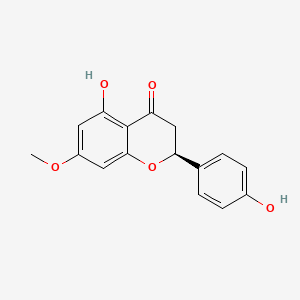| MeSH term | MeSH ID | Detail |
|---|---|---|
| Acne Vulgaris | D000152 | 35 associated lipids |
Sakuranetin
Sakuranetin is a lipid of Polyketides (PK) class. Sakuranetin is associated with abnormalities such as and Neurodegenerative Disorders. The involved functions are known as inhibitors, Drug Interactions, aldehyde reductase activity, Antiinflammatory Effect and antagonists. Sakuranetin often locates in Vacuole and Cell surface. The associated genes with Sakuranetin are PTPN1 gene.
Cross Reference
Introduction
To understand associated biological information of Sakuranetin, we collected biological information of abnormalities, associated pathways, cellular/molecular locations, biological functions, related genes/proteins, lipids and common seen animal/experimental models with organized paragraphs from literatures.
What diseases are associated with Sakuranetin?
Sakuranetin is suspected in Neurodegenerative Disorders and other diseases in descending order of the highest number of associated sentences.
Related references are mostly published in these journals:
| Disease | Cross reference | Weighted score | Related literature |
|---|
Possible diseases from mapped MeSH terms on references
We collected disease MeSH terms mapped to the references associated with Sakuranetin
PubChem Associated disorders and diseases
What pathways are associated with Sakuranetin
There are no associated biomedical information in the current reference collection.
PubChem Biomolecular Interactions and Pathways
Link to PubChem Biomolecular Interactions and PathwaysWhat cellular locations are associated with Sakuranetin?
Visualization in cellular structure
Associated locations are in red color. Not associated locations are in black.
Related references are published most in these journals:
| Location | Cross reference | Weighted score | Related literatures |
|---|
What functions are associated with Sakuranetin?
Related references are published most in these journals:
| Function | Cross reference | Weighted score | Related literatures |
|---|
What lipids are associated with Sakuranetin?
There are no associated biomedical information in the current reference collection.
What genes are associated with Sakuranetin?
Related references are published most in these journals:
| Gene | Cross reference | Weighted score | Related literatures |
|---|
What common seen animal models are associated with Sakuranetin?
There are no associated biomedical information in the current reference collection.
NCBI Entrez Crosslinks
All references with Sakuranetin
Download all related citations| Authors | Title | Published | Journal | PubMed Link |
|---|---|---|---|---|
| Medić-Sarić M et al. | From functional food to medicinal product: systematic approach in analysis of polyphenolics from propolis and wine. | 2009 | Nutr J | pmid:19624827 |
| Rakwal R et al. | Ultra low-dose radiation: stress responses and impacts using rice as a grass model. | 2009 | Int J Mol Sci | pmid:19399245 |
| Oh Y et al. | Transcriptome analysis reveals new insight into appressorium formation and function in the rice blast fungus Magnaporthe oryzae. | 2008 | Genome Biol. | pmid:18492280 |
| Pacciaroni Adel V et al. | Antifungal activity of Heterothalamus alienus metabolites. | 2008 | Phytother Res | pmid:18386258 |
| Chen JJ et al. | Dihydroagarofuranoid sesquiterpenes, a lignan derivative, a benzenoid, and antitubercular constituents from the stem of Microtropis japonica. | 2008 | J. Nat. Prod. | pmid:18471021 |
| Takemoto JK et al. | Stereospecific analysis of sakuranetin by high-performance liquid chromatography: pharmacokinetic and botanical applications. | 2008 | J. Chromatogr. B Analyt. Technol. Biomed. Life Sci. | pmid:18676186 |
| Saito T et al. | Sakuranetin induces adipogenesis of 3T3-L1 cells through enhanced expression of PPARgamma2. | 2008 | Biochem. Biophys. Res. Commun. | pmid:18522800 |
| Zhang L et al. | Three flavonoids targeting the beta-hydroxyacyl-acyl carrier protein dehydratase from Helicobacter pylori: crystal structure characterization with enzymatic inhibition assay. | 2008 | Protein Sci. | pmid:18780820 |
| Sudo E et al. | Gene expression and sensitivity in response to copper stress in rice leaves. | 2008 | J. Exp. Bot. | pmid:18676621 |
| Silva BB et al. | Chemical composition and botanical origin of red propolis, a new type of brazilian propolis. | 2008 | Evid Based Complement Alternat Med | pmid:18830449 |
